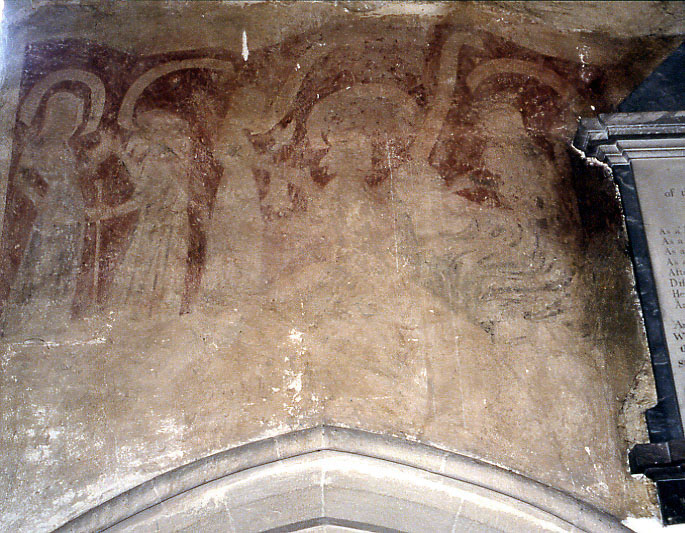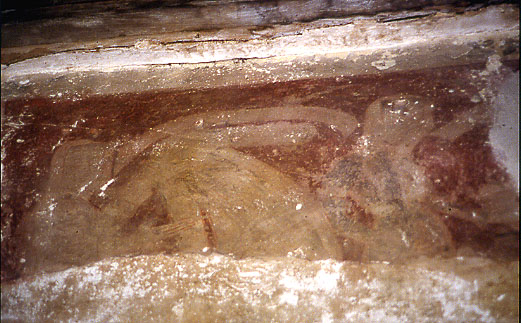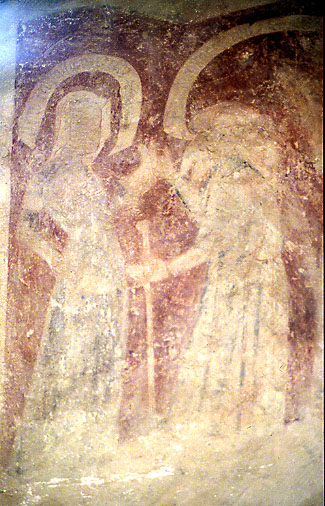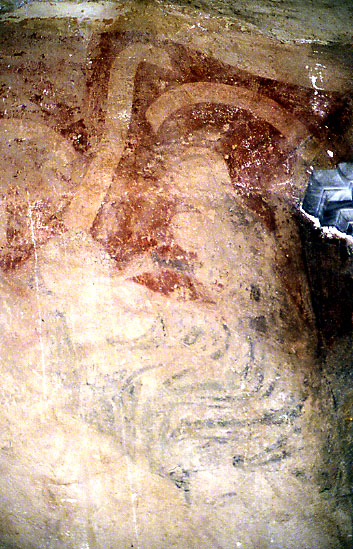Hoxne, Suffolk (†St Edmundsbury & Ipswich) C.14
The Seven Works of Mercy

Hoxne is close to Moulton St Mary, Potter Heigham and Wickhampton (all in Norfolk and in the links table below) and this Seven Works of Mercy is very similar in type to the examples of the subject there. The paintings of the individual Works seem to have been arranged in three tiers, and very little is left of the upper or lower ones.

In the upper tier, though, the scene to the left of the roof-beam at the top of the photograph is Clothing the Naked (detail, right), with a woman at the right handing a voluminous cloak to a another figure at the left. An inscription scroll is in between the two figures, and to the right of the beam is another very faint and incomplete scene not shown here.

The three scenes below are rather clearer. The first, on the left (detail, left) is probably Receiving the Stranger, with a man dressed like a pilgrim with hat and staff to the right of a woman with left hand raised, perhaps offering the pilgrim something.

The central scene of these three (detail, right) has a woman standing at the left and another figure, probably male, apparently sitting at the right. This seated posture suggests that the scene is Visiting the Imprisoned, popularly shown as a visit to a prisoner in the stocks or with shackled feet. Almost all the Works of Mercy on the site present the scene in this way, and in fact there are slight of traces remaining to confirm that the prisoner’s legs and feet are braced apart in this way.

To the right beside the later memorial tablet visible in the main photograph is a scene (detail, right) with what looks like a figure in bed, the bedcover visibly rumpled. A woman stands to the right, probably feeding the person in the bed. This is almost certainly Tending the Sick.
The last scene in the series, Burying the Dead, is at the lower edge of the painting, but apart from a hint of a coffin, it is very faint. Feeding the Hungry and Giving Drink to the Thirsty have disappeared under a large memorial tablet to the right.
There are speech-scrolls in abundance at Hoxne, representing both giver and recipient. None of them is now readable, as is unfortunately true of all examples of this subject I have seen – with the exception of Potter Heigham in Norfolk where the odd (English) word can be made out. Hoxne also has a painting of the Seven Deadly Sins, and the juxtaposition of this subject with the contrasting Seven Works of Mercy is now very rare in the English church, although at least one other example is forthcoming. But arranging the two subjects to complement one another was probably once quite common.